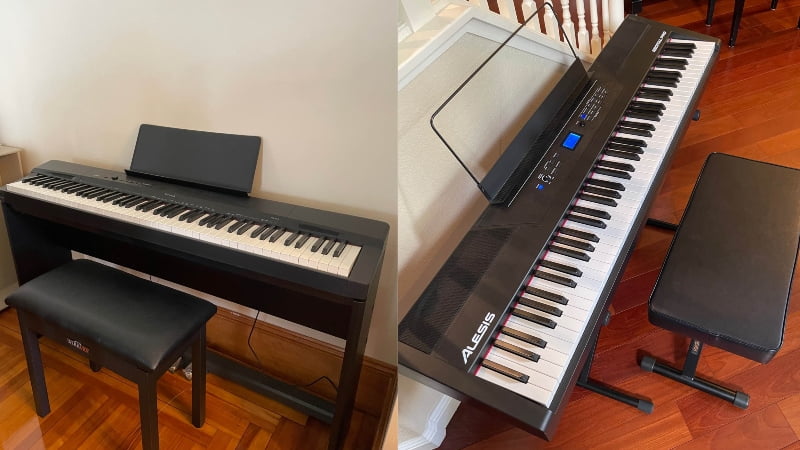For a beginner’s piano, the Alesis Recital Pro offers a whole lot of functionality. In fact, in terms of features and usability, it can even surpass most of the competition in its price. But on the other hand, the Casio PX-160 is widely known as one of the top beginner’s pianos in the market today.
And in this Alesis Recital Pro vs Casio PX 160 comparison, the Casio PX-160 proved its worth. Equipped with a better range of tones, better feel, and a better tone engine, the Casio PX-160 easily beat out the Alesis Recital Pro.
With that said, this isn’t a criticism of the Alesis Recital Pro at all. When doing this comparison, I was pleasantly surprised by how close the Alesis Recital Pro fought in all categories. And while it couldn’t overcome the quality of the PX-160, the Alesis Recital Pro is still arguably one of the best options in its price range.
Alesis Recital Pro vs Casio PX 160: Comparison Chart


Last update on 2025-04-11 / Affiliate links / Images from Amazon Product Advertising API
Alesis Recital Pro vs Casio PX 160: The Differences
When I compared each of the features of these pianos against each other, the final score was 3-1, in favor of the Casio PX-160. But in each comparison, the Alesis Recital Pro gave the Casio a run for its money. And considering that the PX-160 is the more expensive model by a significant amount, it speaks to the quality of the Alesis Recital Pro and its ability to compete with models in higher price ranges.
Feel & Playability
The winner: Casio PX-160
A digital piano that can accurately replicate the feel of an acoustic piano is a key feature for any beginner. And between these two options, the Casio PX-160 offered a more accurate feel with its scaled hammer action and textured keys. I completely expected the Casio PX-160 to have a better feel since it is the more expensive option. With that said, the Alesis Recital Pro was able to put up a fair fight, which was a pleasant surprise considering the price point of this piano.
+ Hammer Action
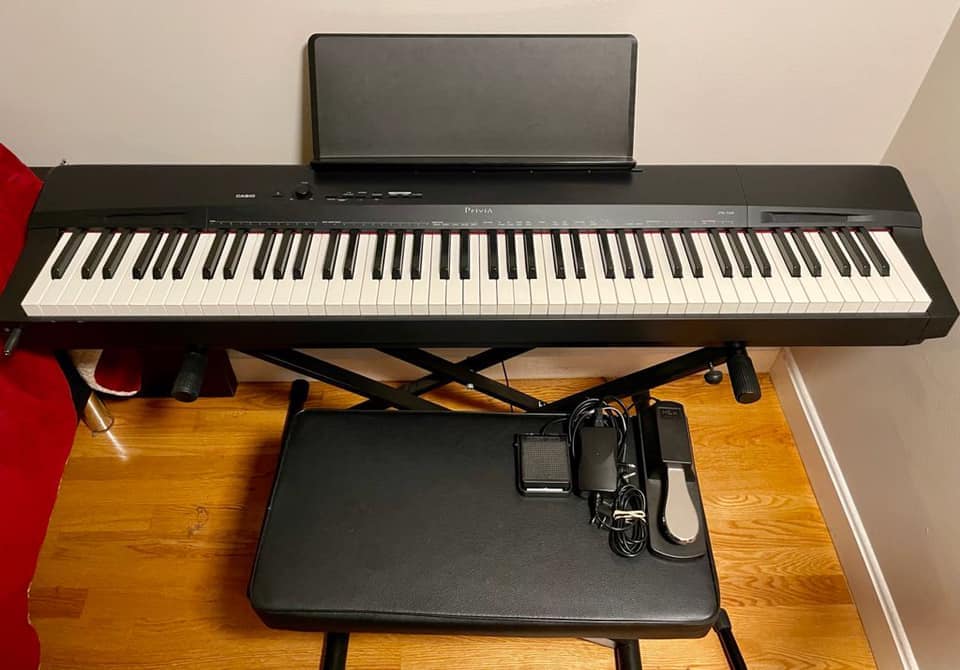
The Casio PX-160 sports scaled hammer action. Sometimes called progressive hammer action, this system replicates the slight differences in the weight of the lower piano keys compared to the higher keys. The Casio PX-160’s keys are significantly heavier on the left side of the piano and it gets progressively lighter as you move through to the higher end of the keyboard.
With the Alesis Recital Pro, you get a relatively uniform hammer action throughout. Since it’s the cheaper option, it’s easy to see why the Alesis Recital Pro doesn’t have a complex system such as the Casio PX-160. However, the Recital Pro does sport fully-weighted keys, so you get a decent weight when you play this piano.
In the price range of the Recital Pro, there are many models that sport a simpler semi-weighted hammer action. This drives down the cost of the piano, but it also takes away a lot of the realism, which is why the Recital Pro can easily beat out a lot of models in its price range.
+ Key Texture
Another area where the PX-160 excelled is in the key texture. In fact, the Casio PX-160 can beat out a lot of models in its price range because it has textured keys. While the keys are still made of plastic, they are finished with a coating to simulate the texture of ebony and ivory keys. The black and white keys on the PX-160 have different coatings, since there is a slight difference in the texture of the black and white keys on an acoustic piano. Most models in the PX-160’s price range don’t care to coat the keys, since this is a tiny detail that most beginners won’t notice anyway, but it’s still a nice feature to have.
Since the Alesis Recital Pro is designed for beginners, there wasn’t much attention paid to the key texture. In fact, the Recital Pro sports plastic keys without any coating at all, so they feel slippery and look glossy. While it would’ve been nice for the piano to sport some sort of coating, it’s not a necessary feature for a beginner’s piano, so this is an easily forgivable flaw.
Tone
The winner: Casio PX-160
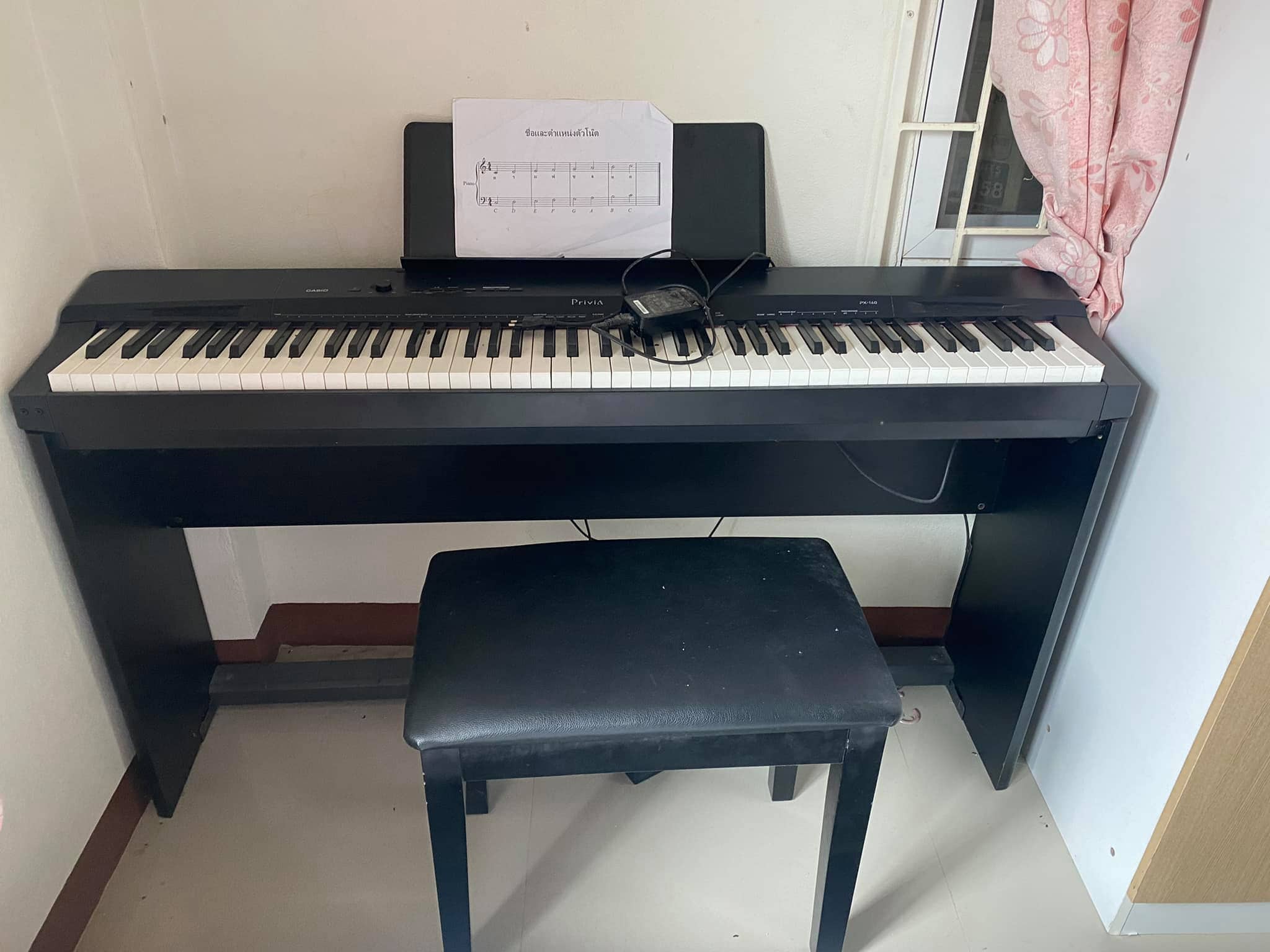
One reason it’s good to invest in a more expensive model is that they usually come with more robust tone engines. This rings very true for the PX-160 as it has the AiR tone generator that is much better than the standard samples on the Alesis Recital Pro. On top of that, the Casio PX-160 has 18 different voices, which is significantly more than the simple 12 voices on the Recital Pro.
+ Tone Generation
The AiR tone engine is a signature of many Casio models. It stands for Acoustic Intelligent Response and is designed to replicate the sound of real acoustic pianos. It does this by using high-quality stereo samples that better simulate the way a piano’s sound waves travel through the air.
At its heart, the AiR tone engine is basically sampling. However, the difference is that this model incorporates 4-layered samples that include much more sonic detail compared to the other pianos on the market today. This is the main reason the Casio PX-160 had much better tones than the Alesis Recital Pro.
Since the Alesis Recital Pro is a basic digital piano, it doesn’t have a complex tone engine like the Casio PX-160. Instead, it uses the basic sampling method for its tones, but since it’s loaded with fairly high-quality samples, it does give off a pretty realistic tone. But compared to the PX-160, the Recital Pro admittedly had much more digital tones, which is the main reason the Casio PX-160 took this point.
+ Sound Library
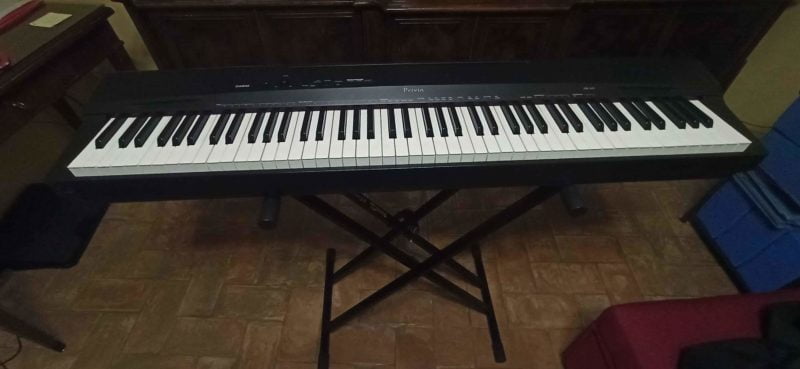
Another way the Casio PX-160 beats out the tone of the Alesis Recital Pro is with its sound library. With digital pianos, you can’t expect that many different tones since the focus is on quality instead of quantity. But with 18 different voices, the Casio PX-160 does offer you a fair amount of versatility compared to other digital pianos on the market.
For comparison, the Alesis Recital Pro offers 12 voices, which is already a bit more than other models in its price range such as the Yamaha P-45, which only has 10 different voices. While both the Casio PX-160 and the Recital Pro offer the same kinds of tones such as organ, piano, synth, bass, and strings voices, you have more choices on the PX-160 which is a big reason it was the winner in this category.
Piano Features
The winner: Tie
To my surprise, when I was testing out this model, I found that they were tied when it came down to the piano features. Since they both have similar playing modes, connectivity options, and even additional effects, it was almost impossible to declare a winner in this comparison.
+ Playing Modes
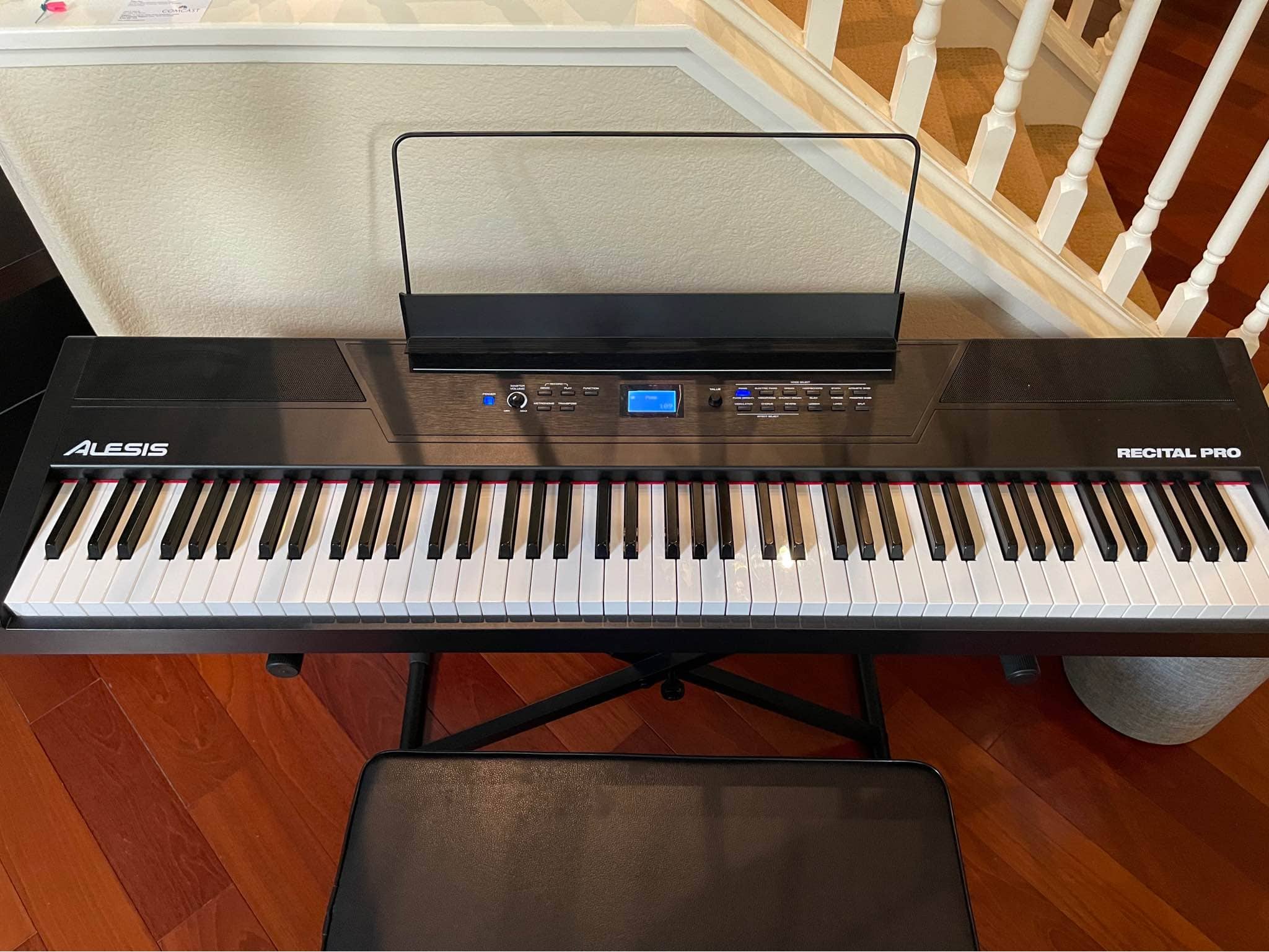
Both of these pianos come with dual mode and duo mode. Sometimes, these modes are called layering and lesson mode, respectively, which is important to keep in mind. With that said, these two modes are incredibly useful for students, teachers, and performing musicians alike, which is why it was great that both pianos featured these playing modes.
Lesson mode divides the piano into two equally tuned mini-keyboards. As the name suggests, this mode is for piano lessons so that the teacher and student can play alongside each other and produce the same pitches without needing two different pianos.
Layering mode allows you to play two different voices at the same time. If you’re performing with another musician, this allows you to add a lot of depth to your tone, which is a huge plus. On top of that, it opens a lot of room for experimentation, which is another plus for pianists looking to find their own unique sound.
One playing mode that was missing with these models is split mode. This is a fairly premium feature, so it’s a let-down that it wasn’t present on the Casio PX-160, which is significantly more expensive than the Alesis Recital Pro. But aside from that, both of these pianos give you a whole lot of versatility with a variety of different playing modes.
+ Connectivity
When it comes to connectivity, these pianos offer all the basic outputs you’ll need for private rehearsals and performing in different venues. You can plug in a pair of headphones when you really want to immerse yourself in the sound while the output to an external speaker allows you to try out a variety of amps and different sound systems.
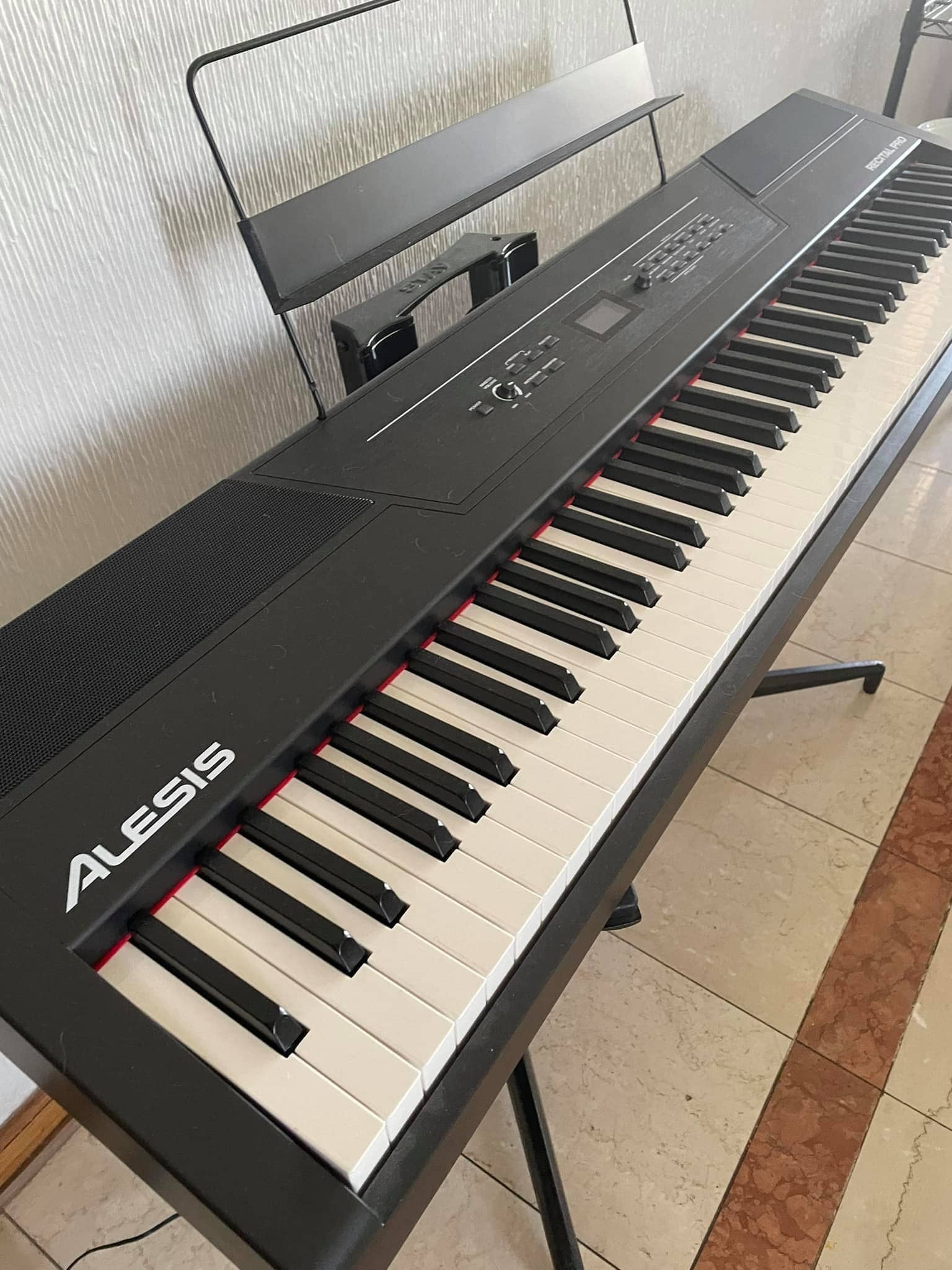
While neither of these pianos have dedicated MIDI ports, they come with USB outputs so that you can still connect the pianos to a computer and control virtual instruments or hook up to piano learning apps.
It would have been a cool extra feature to include BlueTooth connectivity, but sadly, both pianos don’t come with this feature.
+ Effects
The PX-160 comes with reverb, chorus, and brilliance effects. The Alesis Recital Pro also comes with reverb and chorus, but instead of brilliance, it has modulation. Both brilliance and modulation aren’t exactly necessary effects, but they do provide a fair amount of extra versatility.
However, the reverb and chorus effects are arguably the most important and widely-used effects for pianists. These effects allow musicians to add a lot of custom depth and texture to their tone, which is a big reason they are some of the best pianos in their price range today.
Alesis Recital Pro vs Casio PX-160: The Similarities
Despite the fairly different price ranges and features, both these pianos do share some similarities. As we covered earlier, they come with the same playing modes, which honestly speaks to the quality of the Alesis Recital Pro to hold its own against more expensive models like the PX-160.
Another similarity is that these are both portable pianos with 88-key keyboards. If you’re a beginner or a performing musician, this is a great option for you. While both pianos offer the same functionality as any console digital piano, you can easily move these pianos around, which makes it much easier when you need to bring your piano with you to gigs or piano lessons.
But that’s about where the similarities end. These are two very different pianos and while the Alesis Recital Pro is a great budget-friendly option for beginners, the Casio PX-160 comes with a bunch more useful features that justify the higher price tag.
Quick Rundown of the Casio PX 160
- Thanks to the new speaker system (2 x 8 watts) for maximum hearing pleasure when playing alone at home and the new line-out slot for simple connection to external loudspeakers (on stage, in a practice room or at home)
- The pure functions produced by the digital piano make its 18 authentic piano tones sound even better to the ear
- Launching into multi-dimensional AiR sound generation becomes a pleasure with the new PX-160. Keyboard: 88 keysweighted scaled hammer action 3 sensitivity levels, offSimulated ebony and ivory keys
- 3 year manufacturer extended warranty.Hall Simulator/Reverb - 4 (Reverb) Chorus - 4 Brilliance - -3 ~ 0 ~ +3DPS - Yes (Preset for some tones).
- On Stage Classic Single-X Keyboard Stand and Top Stage leather padded piano keyboard bench.Multi-dimensional Morphing AiR Sound SourceStereo-sampled Piano Tones
Last update on 2025-04-11 / Affiliate links / Images from Amazon Product Advertising API
Quick Rundown of the Alesis Recital Pro
- A Digital Piano That’s Tailored to You - Feature-packed electric keyboard with 88 premium full-sized weighted hammer action keys with adjustable touch response to suit your preferred playing style
- Premium Sounds - 12 voices (Incl. Acoustic Piano, Electric Piano, Organ, Synth, and Bass), built-in FX: Chorus, Modulation, Reverb, and two built in 20W speakers for clear, room-filling sound
- All The Right Connections - ¼” sustain pedal input (pedal not included), ¼” stereo headphone output for private practice and stereo outputs for connection to speakers / amplifiers
- Play the Keyboard Wherever You Go - Power via the included power adapter or 6 D cell batteries (not included) for professional piano performance anywhere
- Powerful Educational Features - Standard, split, layer, record and lesson modes with 128-note max polyphony and Skoove 3 month premium subscription for expert interactive online piano lessons
Last update on 2025-04-12 / Affiliate links / Images from Amazon Product Advertising API
Product Videos
Related Articles to Casio Px 160
- Casio PX-770 vs PX-160: Should You Get A Portable or Console Digital Piano?
- Yamaha P71 vs Casio PX-160 Comparison: Battle of the Two Best Digital Pianos on a Budget
Related Articles to Alesis Recital Pro
- Alesis Recital Pro vs Williams Legato III: Discover the Best Piano for Your Home
- Alesis Recital Pro vs Roland Go Piano 88 Comparison: Which Is The Best Portable Digital Piano?
- Alesis Recital Pro vs Yamaha NP32 Comparison: Discover the Best Piano for Your Home
- Kawai ES110 Vs Alesis Recital Pro: Should You Shell Out for the Kawai ES110?
- Alesis Recital Pro vs Prestige Comparison: Choosing the Best Entry-Level Alesis Piano
- Alesis Recital Pro vs Casio CDP-135: Which Is the Best Beginner’s Digital Piano?
- Alesis Recital Pro vs Roland FP-30: Finding the Best Digital Piano on a Budget
- Alesis Recital Pro vs Casio CDP-S150 Comparison: Which Is The Best Portable Digital Piano?
- Alesis Virtue vs Recital Pro: Which Piano Offers The Most For Beginners?
- Alesis Recital Pro vs Roland FP 10: Why You Should Go For The Alesis Recital Pro
- Alesis Recital Pro vs Korg B2 Comparison: Which Digital Piano Should You Get?
- Alesis Recital Pro vs Williams Allegro 3 Comparison: Which One Is Worth Your Money?
- Alesis Recital Pro vs Yamaha P125 Comparison: Which Is The Best Portable Digital Piano?
- Alesis Recital vs Alesis Recital Pro: Should You Invest In The Recital Pro?
- Alesis Recital Pro vs Yamaha P45: Which Should You Get As Your First Piano?
- Donner DEP-20 vs Alesis Recital Pro Comparison: Two Great Pianos Designed for Beginners
- Alesis Prestige Artist vs Recital Pro: Which Is the Best Alesis Piano for Beginners?
- Yamaha P71 vs Alesis Recital Pro: Which Digital Piano is the Best Option for Beginners?
References
- PX 160 Specfications: https://www.casio-intl.com/asia/en/emi/products/px160/spec/
- Recital Pro 88-Key Digital Piano with Hammer-Action Keys: https://www.alesis.com/products/view/recital-pro
Lulacruza is an electronic folk duo operating at the junction of the hypermodern and the ancient. Our music weaves together hypnotic female singing, South American folk instruments and electronic processing, while channeling pulsating waves from the source of creation.
Lalucruza is also a community where you can connect with other music lovers to collaborate, exchange ideas and share knowledge. A platform for who wants to learns the basics of playing piano, guitar, drum masters’ technique, etc.. is the premise of our website.
